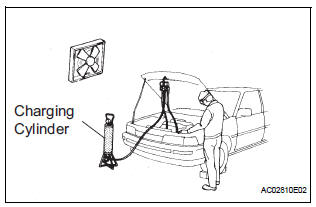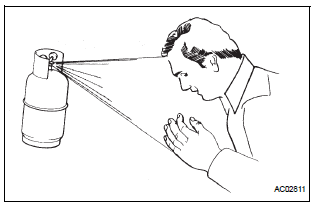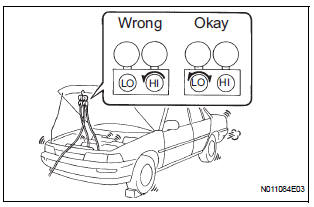Toyota Sienna Service Manual: Precaution
NOTICE: Because the compressor operates at high voltages, wear electric insulated gloves and pull out the service plug to cut the high-voltage circuit before inspection.
1. DO NOT HANDLE REFRIGERANT IN AN ENCLOSED AREA OR NEAR AN OPEN FLAME
2. ALWAYS WEAR EYE PROTECTION

3. BE CAREFUL NOT TO GET LIQUID REFRIGERANT IN YOUR EYES OR ON YOUR SKIN

If liquid refrigerant gets in your eyes or on your skin:
(a) Wash the area with lots of cold water.
| CAUTION: Do not rub your eyes or skin. |
(b) Apply clean petroleum jelly to the skin.
(c) Go immediately to a hospital or see a physician for professional treatment.
4. NEVER HEAT CONTAINER OR EXPOSE IT TO OPEN FLAME
5. BE CAREFUL NOT TO DROP CONTAINER OR APPLY PHYSICAL SHOCKS TO IT
6. DO NOT OPERATE COMPRESSOR WITHOUT ENOUGH REFRIGERANT IN REFRIGERANT SYSTEM

If there is not enough refrigerant in the A/C system, oil lubrication will be insufficient and the compressor may be damaged.
Necessary care should be taken to avoid this.
7. DO NOT OPEN HIGH PRESSURE MANIFOLD VALVE WHILE COMPRESSOR IS OPERATING
Open and close only the low pressure valve. If the high pressure values are opened, refrigerant flows in the reverse direction causing the charging cylinder to rupture.
If the high pressure valve is opened, refrigerant flows in the reverse direction causing the charging cylinder to rupture.
8. BE CAREFUL NOT TO OVERCHARGE SYSTEM WITH REFRIGERANT
If refrigerant is overcharged, it causes problems such as insufficient cooling, poor fuel economy, engine overheating, etc.
9. SUPPLEMENTAL RESTRAINT SYSTEM (SRS)
(a) This vehicle is equipped with an SRS (Supplemental Restraint System) such as the driver, front passenger, side, curtain shield air bags etc..
Failure to carry out service operation in the correct sequence could cause the SRS to unexpectedly deploy during servicing, possibly leading to a serious accident. Before servicing (including removal or installation of parts, inspection or replacement), be sure to read the precautionary notices on (See page RS-1).
10. GENERAL PRECAUTION
(a) While using the battery during inspection, do not bring the positive and negative tester probes too close to each other as a short circuit may occur.
 Parts location
Parts location
...
Other materials:
Front floor footrest
COMPONENTS
Removal
1. REMOVE FRONT FLOOR FOOTREST
Using a screwdriver, disengage the 2 clips and
remove the footrest.
HINT:
Tape the screwdriver tip before use.
Disengage the clips and then remove the 2 clips
from the footrest.
INSTALLATION
1. INSTALL FRONT FLOOR FOOTREST ...
Removal
1. REMOVE FRONT WHEEL
2. REMOVE REAR WHEEL
3. REMOVE TIRE PRESSURE WARNING VALVE AND TRANSMITTER
(a) Remove the valve core and cap, and release the air
from the tire.
(b) After ensuring that a sufficient amount of air has
been released, remove the nut and washer that are
used to secure ...
Low Battery Positive Voltage
DTC C1241/41 Low Battery Positive Voltage
DESCRIPTION
If there is a problem with the brake actuator assembly (skid control ECU)
power supply circuit, the skid
control ECU outputs the DTC and prohibits the ABS operation with the fail safe
function.
If the voltage supplied to the IG1 termina ...

